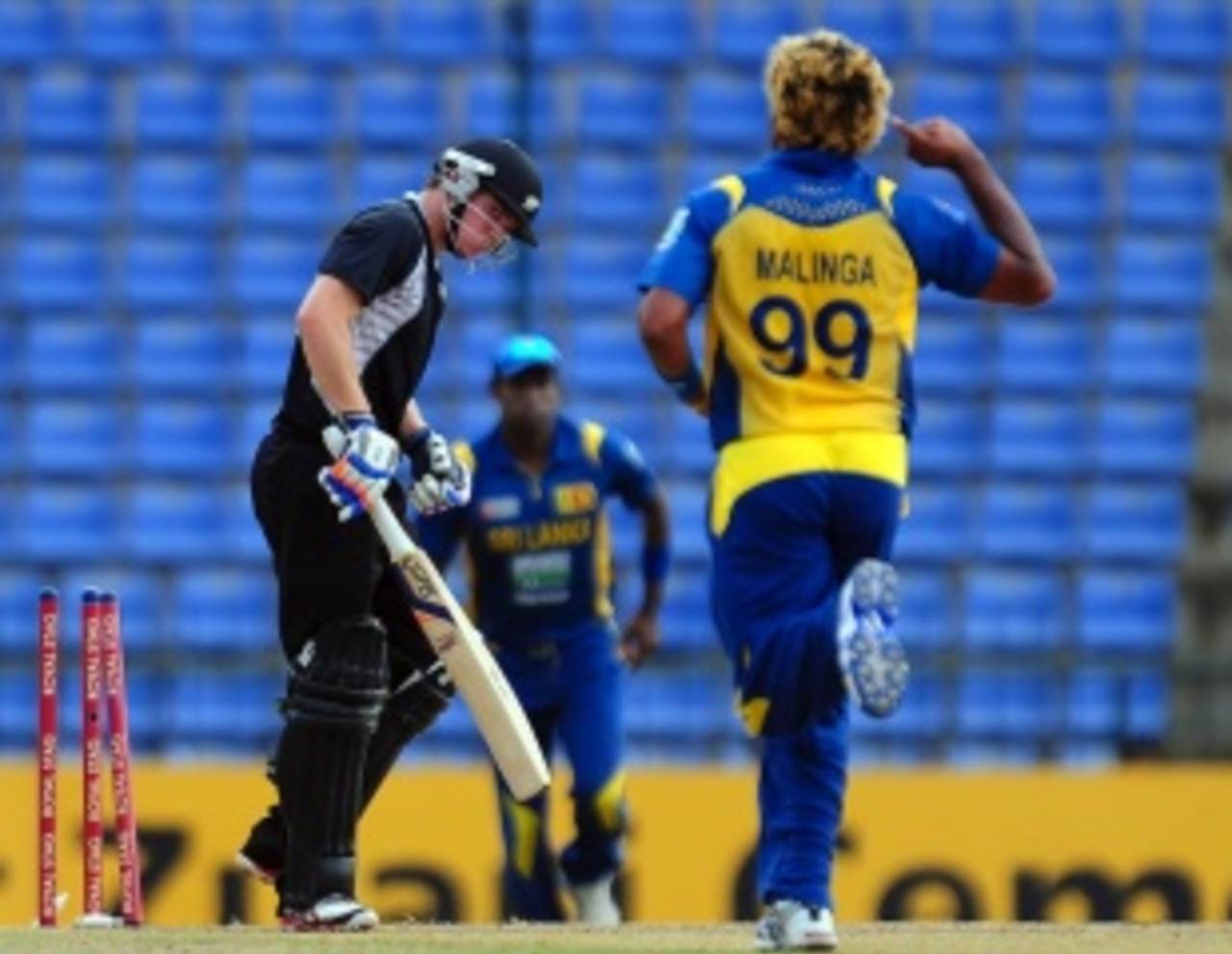Malinga shows steel and skill
The Sri Lanka fast bowler proved he had the heart to go from the most devastating match in his career, to being Man of the Match in the next
Andrew Fernando in Pallekele
04-Nov-2012

He failed in the World Twenty20 final, prompting much criticism but on Monday he again showed why he's such a prized asset for Sri Lanka • AFP
Four Sundays ago, the second ball of Lasith Malinga's second over was thumped off the pads over midwicket for six. It was the violent beginning to Marlon Samuels' World Twenty20 final rampage and the delivery upon which the trophy pivoted.
For the remainder of the over, Malinga tried sticking to yorkers; the delivery he had worshipped as a teenager before becoming its foremost disciple as a cricketer. He had himself turned matches with that ball; reaped sensational success with the way he got it to dip and swerve well after the batsman had begun playing at it. This time though, his most trusted instrument failed him. Twice he overpitched and was scourged over cover and long on. His next over was no less painful. He has since said it was his most difficult day on a cricket field and blamed himself for his side's defeat.
In the time since he has endured much criticism, and his motivation has been questioned. Whatever Malinga may say about his knee injury, he must accept that Test retirement was not best announced during a lucrative tournament which he would have had to miss part of, if he were to continue playing Tests. Whatever the reason behind that timing, it invited doubt about his commitment to Sri Lanka.
But against New Zealand, in his very next international match, Malinga responded to his critics by his performance, the way all the best cricketers do. He was intense at the beginning, skidding through with pace in the channel outside off stump.
The Pallekele pitch had lost a great deal of bounce in the five days since the opening Twenty20, and the low carry initially served to further vex the New Zealand openers, neither of whom had seen much of Malinga's low-arm action. Rob Nicol could barely lay bat on ball in Malinga's first spell. Often Malinga would bring the ball in, before moving it away a touch off the seam. If Angelo Mathews had been positioned closer to the keeper at first slip, Malinga should have removed him for 4. Tom Latham was not so fortunate. Malinga angled one across him, and the ball kept low and skidded in between bat and pad to clip off stump. In his first five overs, he rarely allowed the batsman to safely leave the ball. The spell cost 12 runs - much of that in edges.
He returned to deliver three more during the batting Powerplay. In his first spell, Malinga had gone full and low, but with Ross Taylor batting well, he changed his approach. The fast, uncomfortable bouncers that had been missing almost entirely during Sri Lanka's World Twenty20 campaign became a feature of his next three overs. He pitched short to Taylor several times in a short period, but as length is more difficult to determine with Malinga's low arm, Taylor was surprised each time. Once he was hit on the glove, another time, flush on the helmet. Taylor tried to pull and hook, but in the end, the best he could do was to fend him away for singles.
At the death New Zealand got Malinga away for one four - only the second he had conceded in the day, and the first had been the edge past Mathews. The yorkers were humming nicely, only without the late swing he used to generate before the rule that made reverse swing obsolete in ODIs. He then put a neat full stop on a plucky performance, when he got one to dip beneath Andrew Ellis' bat, to take the base of leg stump off the last ball of the innings.
Mahela Jayawardene had backed Malinga to the hilt on the night of the final, and had been roundly chastised himself for that decision. Jaywardene is generally a master at sizing up conditions, but on that occasion he had allowed West Indies to have the pace on the ball that Malinga provided on a sluggish pitch, when he still had slow bowling options available. But in their next match together, the relationship between captain and strike bowler had not been shaken. Jayawardene still relied on Malinga to deliver the most high-pressure overs of the innings.
"I think I've often repaid that trust when he has given the ball to me," Malinga had said before the match. "I have bowled well in those pressure situations and given the team what it expects. I couldn't do that in the final, but I think that's why Mahela gives me the ball in those situations."
For much of his career, Malinga has been a player who has been given the toughest job on the field, and often he has done it well. No one can doubt his form has slipped over the past year, as his figures against India in particular, clearly lay out. But if anyone doubted his hunger, perhaps his 2 for 39 from 10 overs in this match will placate them. It takes heart to go from the most devastating match in one's career, to being Man of the Match in the next.
Andrew Fernando is ESPNcricinfo's correspondent in Sri Lanka